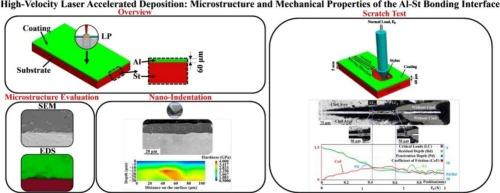High-velocity laser accelerated deposition: Microstructure and mechanical properties of the aluminum-steel bonding interface
IF 5.3
2区 材料科学
Q1 MATERIALS SCIENCE, COATINGS & FILMS
引用次数: 0
Abstract
High-velocity laser accelerated deposition (HVLAD) is a cladding method that can achieve uniform adhesion between coating-substrate systems with unprecedented potential. Unlike thermally driven processes, HVLAD relies on laser peening technology to propel small areas of a thin film onto a substrate. An essential aspect of this technique is that it prevents significant temperature variations between the substrate and thin film, reducing the likelihood of thermally induced defects. An intense plasma pressure wave generated by the laser pulse, along with micro-level melting that occurs at the interface, leads to complex microstructure at the interface. This research studies the bonding process of 1100 aluminum (Al) of approximately 60 μm thickness to a 52,100 steel (St) substrate using this technique. The microstructure at the interface as well as nano hardness, and bonding strength using advanced microscopy and indentation techniques were investigated. It was concluded that the substantial grain refinement observed near the weld interface might be linked to the intense pressure as well as the melting and subsequent recrystallization induced by the high-speed heating and cooling rates inherent in the HVLAD process. Measurements of the scratch resistance and adhesion of the cladded aluminum coatings showed a critical load of delamination initiation in the range of 1–2 N. While this study focused on the bonding of Al and St, additional research is needed for other materials. With further development, HVLAD has the potential for cost-effective coating deposition on complex geometries without strength limitations. This method can apply corrosion-resistant, wear-resistant, thermal-resistant, and impact-resistant coatings with strong bonding on the substrate.

高速激光加速沉积:铝钢结合界面的微观结构和机械性能
高速激光加速沉积(HVLAD)是一种覆层方法,可实现涂层-基底系统之间的均匀附着,具有前所未有的潜力。与热驱动工艺不同,HVLAD 依靠激光强化技术将小面积薄膜推进到基底上。这种技术的一个重要方面是,它可以防止基底和薄膜之间出现明显的温度变化,从而降低热引起缺陷的可能性。激光脉冲产生的强烈等离子体压力波以及在界面上发生的微级熔化会导致界面上出现复杂的微观结构。本研究采用这种技术对厚度约为 60 μm 的 1100 铝(Al)与 52100 钢(St)基材的粘接过程进行了研究。使用先进的显微镜和压痕技术对界面的微观结构、纳米硬度和粘接强度进行了研究。得出的结论是,在焊接界面附近观察到的大量晶粒细化可能与 HVLAD 工艺固有的高速加热和冷却速率引起的高压、熔化和随后的再结晶有关。对包覆铝涂层的抗划伤性和附着力的测量显示,分层开始的临界载荷在 1-2 N 之间。随着进一步的发展,HVLAD 有可能在复杂几何形状上实现经济高效的涂层沉积,而不受强度限制。这种方法可以在基体上涂覆抗腐蚀、抗磨损、抗热和抗冲击涂层,并具有很强的粘结性。
本文章由计算机程序翻译,如有差异,请以英文原文为准。
求助全文
约1分钟内获得全文
求助全文
来源期刊

Surface & Coatings Technology
工程技术-材料科学:膜
CiteScore
10.00
自引率
11.10%
发文量
921
审稿时长
19 days
期刊介绍:
Surface and Coatings Technology is an international archival journal publishing scientific papers on significant developments in surface and interface engineering to modify and improve the surface properties of materials for protection in demanding contact conditions or aggressive environments, or for enhanced functional performance. Contributions range from original scientific articles concerned with fundamental and applied aspects of research or direct applications of metallic, inorganic, organic and composite coatings, to invited reviews of current technology in specific areas. Papers submitted to this journal are expected to be in line with the following aspects in processes, and properties/performance:
A. Processes: Physical and chemical vapour deposition techniques, thermal and plasma spraying, surface modification by directed energy techniques such as ion, electron and laser beams, thermo-chemical treatment, wet chemical and electrochemical processes such as plating, sol-gel coating, anodization, plasma electrolytic oxidation, etc., but excluding painting.
B. Properties/performance: friction performance, wear resistance (e.g., abrasion, erosion, fretting, etc), corrosion and oxidation resistance, thermal protection, diffusion resistance, hydrophilicity/hydrophobicity, and properties relevant to smart materials behaviour and enhanced multifunctional performance for environmental, energy and medical applications, but excluding device aspects.
 求助内容:
求助内容: 应助结果提醒方式:
应助结果提醒方式:


